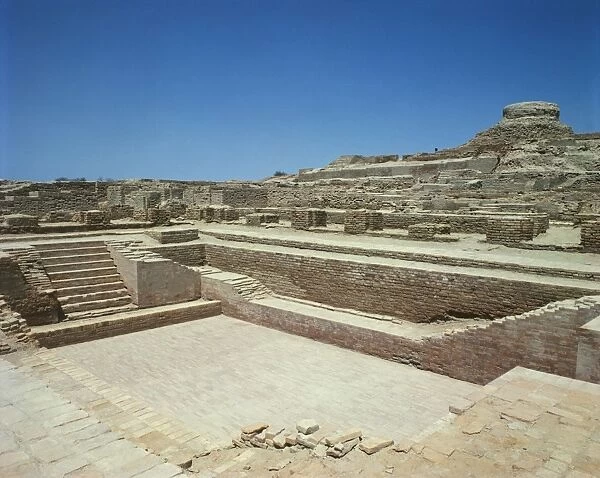Table of Contents
The Great Bath is one of the most iconic structures of the Indus Valley Civilization, specifically located in the ancient city of Mohenjo-Daro. This impressive architectural feat offers a glimpse into the sophisticated urban planning, social practices, and technological advancements of one of the world’s earliest urban cultures. This article explores the significance, structure, and purpose of the Great Bath, shedding light on its role within the broader context of the Indus Valley Civilization.
Architectural Marvel of Great Bath
Design and Construction
The Great Bath is a testament to the advanced engineering skills of the Harappans. Measuring approximately 12 meters long, 7 meters wide, and 2.4 meters deep, the structure was built using meticulously cut bricks, gypsum mortar, and bitumen to ensure watertightness. The precision in construction reflects the Harappans’ deep understanding of materials and their properties.
Waterproofing Techniques
One of the most remarkable aspects of the Great Bath is its waterproofing. The use of bitumen (a natural tar) to seal the bricks ensured that the structure could hold water without leakage. This technique highlights the Harappans’ innovative approach to construction, making the Great Bath one of the earliest known examples of advanced waterproofing in architecture.
Water Management System
The Great Bath was part of a sophisticated water management system that included a series of drains, wells, and channels. Water was likely supplied through a well or a series of underground channels and drained through a complex network of covered drains. This efficient system underscores the Harappans’ expertise in hydraulic engineering and urban planning.
Social and Cultural Significance of Great Bath
Ritualistic Purposes
The prevailing theory among archaeologists is that the Great Bath was used for ritualistic purposes. Its central location within the citadel of Mohenjo-Daro suggests it played a significant role in the religious and ceremonial life of the city. The importance of water in cleansing and purification rituals is well-documented in many ancient cultures, and the Great Bath likely served a similar function in the Indus Valley Civilization.
Public Gatherings
In addition to its religious significance, the Great Bath may have served as a venue for public gatherings and communal activities. Its size and prominent location suggest it was a focal point for social interaction, possibly hosting festivals, ceremonies, or other communal events that reinforced social cohesion.
Technological Advancements of Great Bath
Advanced Urban Planning
The construction of the Great Bath within a well-planned urban environment speaks volumes about the level of administrative control and organizational capacity of the Indus Valley Civilization. The precise alignment of streets, the uniformity of bricks, and the integration of public structures like the Great Bath demonstrate a high degree of urban planning and governance.
Engineering Skills
The engineering skills required to build and maintain the Great Bath were considerable. The structure’s durability, achieved through advanced building techniques and materials, indicates a deep understanding of civil engineering principles. The Great Bath not only served a practical purpose but also symbolized the technological prowess of the Harappans.
Comparative Analysis of Great Bath
Similar Structures in Ancient Civilizations
Comparing the Great Bath with similar structures from other ancient civilizations provides valuable insights. For instance, the use of water for ritualistic purposes is evident in ancient Mesopotamian ziggurats, Egyptian temples, and Greek and Roman baths. However, the Great Bath’s scale and sophistication were unparalleled at its time, marking it as a unique achievement in ancient architecture.
Influence on Later Cultures
The technological and architectural innovations of the Harappans, exemplified by the Great Bath, likely influenced later cultures. The emphasis on public hygiene, urban planning, and water management seen in subsequent civilizations can trace some of their origins to the practices developed in the Indus Valley.
Preservation and Legacy of Great Bath
Archaeological Significance
The discovery of the Great Bath has been crucial in understanding the Indus Valley Civilization. Excavated in the 1920s by British archaeologist Sir John Marshall, the structure has provided invaluable information about the social and cultural practices of the Harappans. Ongoing archaeological efforts continue to uncover new aspects of this enigmatic civilization.
Cultural Heritage
The Great Bath remains a symbol of the ingenuity and sophistication of the Indus Valley Civilization. As a UNESCO World Heritage Site, it represents an important cultural heritage that offers insights into the early development of urban societies. Preserving such structures is essential for future generations to appreciate and learn from the achievements of ancient civilizations.
Conclusion
The Great Bath of Mohenjo-Daro stands as a monumental achievement of the Indus Valley Civilization, reflecting their advanced engineering, urban planning, and cultural practices. Its construction, purpose, and legacy offer a window into a civilization that, despite its ancient origins, continues to fascinate and inspire. The Great Bath not only showcases the technical prowess of the Harappans but also underscores their commitment to social and ritualistic practices that defined their way of life.
FAQs
What was the purpose of the Great Bath in the Indus Valley Civilization?
The Great Bath was likely used for ritualistic purposes, including cleansing and purification ceremonies. It may have also served as a venue for public gatherings and social activities.
How did the Harappans waterproof the Great Bath?
The Harappans used bitumen, a natural tar, to seal the bricks and ensure that the Great Bath could hold water without leakage, showcasing their advanced waterproofing techniques.
What does the Great Bath reveal about Harappan urban planning?
The construction of the Great Bath within a well-planned urban environment indicates a high level of administrative control and sophisticated urban planning, with an emphasis on public structures and efficient water management.
How does the Great Bath compare to similar structures in other ancient civilizations?
While many ancient civilizations-built structures for ritualistic water use, the Great Bath’s scale and sophistication were unparalleled at its time, making it a unique architectural achievement.
Why is the Great Bath important for understanding the Indus Valley Civilization?
The Great Bath provides crucial insights into the social, cultural, and technological practices of the Harappans, highlighting their engineering skills, urban planning, and emphasis on ritualistic practices.






Leave a Reply